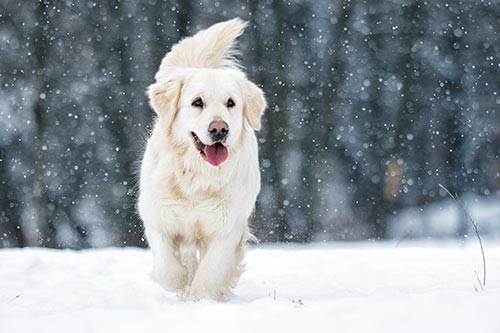Common Signs of Frostbite in Dogs
Winter weather can be hard on dogs, especially when temperatures drop below freezing. Just like humans, dogs are susceptible to frostbite, a condition that occurs when the skin and underlying tissues freeze due to prolonged exposure to the cold. In this blog, we’ll explore the signs of frostbite in dogs, so you’ll know when to take action and protect your pet. If you notice any signs that your dog may be experiencing frostbite, we encourage you to call LePar Animal Hospital at (708) 423-3200 to speak with our team or make an appointment.

What Is Frostbite in Dogs?
Frostbite occurs when a dog’s body is exposed to cold temperatures for an extended period. The body works hard to stay warm, and to do that, it focuses on keeping the core (heart and lungs) warm. As a result, blood flow to the extremities, like the ears, paws, and tail, decreases. Without proper blood flow, these areas are at risk of freezing. This is what leads to frostbite.
While all dogs can experience frostbite, some may be more susceptible than others. Smaller dogs, those with short coats, and those that are left outside in the cold for too long are particularly at risk. It’s important to monitor your dog during cold weather, especially if they spend a lot of time outside.
Early Signs of Frostbite in Dogs
The signs of frostbite in dogs may not be immediately obvious. However, as the condition progresses, certain symptoms will become more noticeable. Early detection can make a big difference, so it’s helpful to know what to look for when your dog has been exposed to freezing temperatures.
One of the first signs of frostbite is cold skin. The skin on your dog’s ears, paws, and tail may feel very cold to the touch. You may also notice your dog shivering, which is the body’s natural response to cold. Shivering helps generate warmth, but it can also be an indicator that your dog has been in the cold for too long.
Another early sign is discoloration of the skin. Frostbitten areas may appear pale or gray, as the blood flow has been reduced to those areas. If the frostbite is severe, the skin can even turn blue or purple. This change in skin color is a warning that your dog’s body is not able to warm those areas properly, and it may indicate that frostbite is setting in.
Advanced Symptoms of Frostbite in Dogs
As frostbite worsens, the symptoms will become more pronounced. One common sign is swelling in the affected areas. Swollen ears, paws, or tail could indicate that the tissue is starting to freeze. The tissue may also become hard or brittle. This happens because the freezing process causes ice crystals to form within the tissue, leading to a lack of flexibility and a stiff texture.
Blisters or ulcers may also appear as frostbite progresses. These sores are often painful for your dog and can make walking or moving difficult. If you notice blisters forming, it’s a sign that the tissue damage is significant. At this point, the frostbitten area is at risk of infection, which can further complicate the situation.
Another serious symptom is pain or discomfort in the frostbitten area. Dogs may lick, chew, or bite at the affected spots in an attempt to relieve the discomfort. You might also notice them limping or avoiding using a frostbitten paw. If your dog is exhibiting any of these behaviors, it’s important to contact LePar Animal Hospital right away to get them evaluated.
Severe Frostbite and Tissue Death
If frostbite is not treated, the affected tissue can begin to die. When this happens, the area may turn black or become necrotic. This indicates that the tissue has been irreversibly damaged and is no longer viable. In some cases, the dead tissue may even fall off, particularly in areas like the tips of the ears or the tail.
Severe frostbite can lead to long-term health problems for your dog, including infection, tissue loss, or the need for amputation. This is why it’s important to act quickly if you suspect your dog has frostbite. The sooner you address the issue, the better the chances are of minimizing the damage.
How to Check Your Dog for Frostbite
If your dog has been out in freezing temperatures, it’s a good idea to check for any signs of frostbite as soon as they come inside. Start by feeling their ears, paws, and tail for any areas that feel cold or stiff. Gently inspect the skin for any discoloration, swelling, or blisters. Be sure to look for any signs that your dog is in pain or discomfort, such as limping or excessive licking.
Keep in mind that dogs with thick fur may be more challenging to assess, as their coat can make it harder to see the affected areas. However, it’s still possible for them to get frostbite, so don’t assume that their coat provides complete protection.
Preventing Frostbite in Dogs
While this blog focuses on the signs of frostbite in dogs, it’s important to mention prevention. Keeping your dog warm during winter weather is the best way to prevent frostbite. If your dog spends a lot of time outside, make sure they have a sheltered space where they can get out of the cold. A heated doghouse or an insulated shelter can help provide extra protection. You can also invest in dog booties or a winter coat to help keep their paws and body warm.
It’s also a good idea to limit the amount of time your dog spends outside when temperatures drop below freezing. Even short walks can lead to frostbite if your dog is exposed to extreme cold for too long. After outdoor activities, check your dog’s extremities to ensure they are warm and dry.
When to Call LePar Animal Hospital
If you notice any signs of frostbite in your dog, it’s important to seek veterinary care as soon as possible. While mild cases of frostbite may resolve with time, more severe cases require professional treatment to prevent complications like infection or tissue loss. Our team at LePar Animal Hospital is here to help if your dog has been exposed to extreme cold. Call us at (708) 423-3200 for more information or to make an appointment.
Our veterinarians can evaluate the severity of your dog’s frostbite and provide the appropriate care to ensure the best possible outcome. Depending on the severity, treatment may involve warming the affected areas, treating any open sores or blisters, and managing pain. In severe cases, surgical intervention may be necessary to remove dead tissue.
Helping Your Dog Recover from Frostbite
Recovery from frostbite can take time, and it’s important to follow your veterinarian’s instructions closely. Your dog may need to stay indoors and avoid cold weather while they heal. In some cases, they may need to wear protective coverings on their paws or ears to prevent further injury. Your veterinarian will guide you on how to care for your dog at home, including any medications or special treatments that may be necessary.
In most cases, dogs recover well from frostbite if it is caught and treated early. However, it’s important to keep in mind that frostbite can be painful and uncomfortable for your dog. Providing them with a warm, safe environment during their recovery can help make the healing process smoother.
By learning the signs of frostbite in dogs, you can act quickly to protect your pet from cold-related injuries. If you have any concerns about your dog’s exposure to cold weather or suspect they may have frostbite, don’t hesitate to reach out to us at LePar Animal Hospital. We’re here to help your dog stay healthy and happy, no matter the weather.
Recent Posts
About Us
LePar Animal Hospital has served generations of pets and families in Evergreen Park, Oak Lawn, Palos, and neighboring suburbs, and we hope to serve generations more! Our animal hospital is accredited by the American Animal Hospital Association (AAHA) and staffed with Fear Free Certified veterinarians providing a multitude of services, from wellness and dental care to acupuncture, chemotherapy, and surgery.
